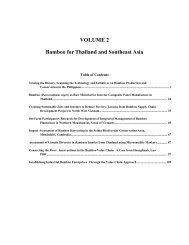WBC-VIII-Vol.4 – Resources – Forestry, Plantations and ... - BambuSC
WBC-VIII-Vol.4 – Resources – Forestry, Plantations and ... - BambuSC
WBC-VIII-Vol.4 – Resources – Forestry, Plantations and ... - BambuSC
Create successful ePaper yourself
Turn your PDF publications into a flip-book with our unique Google optimized e-Paper software.
Soil :<br />
Most bamboos are found in s<strong>and</strong>y loam to loamy clay soil, derived form river alluvium or underlying rock.<br />
Although bamboo, like other commercial crops prefer a well drained soil, it is observed even in swampy soils<br />
<strong>and</strong> wet stream beds. The soils of the districts vary from clay to clay loam to s<strong>and</strong>y loam <strong>and</strong> soil reaction is<br />
acidic with pH of 4.5 to 7.0. A luxurious growth of bamboo is a common feature in the districts <strong>and</strong> therefore<br />
the soil <strong>and</strong> climatic conditions are best suited for cultivation of bamboo.<br />
Species:<br />
Among many indigenous bamboo species growing in Assam, only 2 species are cultivated by farmers viz, B.<br />
tulda <strong>and</strong> B. balcooa. However, the most common bamboo available in the districts <strong>and</strong> most favored by the<br />
farmers is jati bamboo B. tulda. So it is proposed to plant only jati bamboo for the present project.<br />
Planting Material:<br />
There are various methods of propagating bamboo viz. through seed <strong>and</strong> vegetative methods including tissue<br />
culture. The vegetative method i.e mainly rhizomes have been considered under the project because this is not<br />
only the traditional method of bamboo cultivation, but also most favored by the farmers because of quick yields.<br />
Besides, the progressive bamboo farmers have been identified for supplying rhizomes to the farmers. It has also<br />
been observed that plenty of rhizomes are available in the project areas.<br />
Raising of the plantations:<br />
The planting will be taken up during the period January to March. Pits of 60 cm3 will be dug <strong>and</strong> FYM will be<br />
put inside the pits before the Rhizomes are planted at a spacing of 4m x 4 m. The number of plants per bigha is<br />
estimated at 85. A provision has been made for casualty replacement in the second year to the extent of 10%.<br />
Fencing :<br />
Live hedge fencing has been recommended as it is essential to protect Bamboos in initial years from grazing by<br />
stray cows <strong>and</strong> goats, because bamboo leaves are fodder <strong>and</strong> voraciously eaten by the animals.<br />
Fertilization :<br />
Bamboo is a heavy feeder <strong>and</strong> therefore, even rich soils might becomes depleted after a few years if no fertilizer<br />
is added. Although fertilizers may be applied at any time in the year, it is preferred to apply fertilizer after<br />
harvest <strong>and</strong> before irrigation. It should be noted that rhizomes continue to be active (growing) except during the<br />
coldest part of the year. It is therefore proper to apply small quantities of fertilizer round the year rather than in<br />
one/two large doses. Bamboo responds well to nitrogen <strong>and</strong> potassium which are found in compost, green<br />
manure, wood ash <strong>and</strong> chemical fertilizers. Lime is often applied to neutralise soil acidity.<br />
<strong>VIII</strong> World Bamboo Congress Proceedings Vol 4-6




